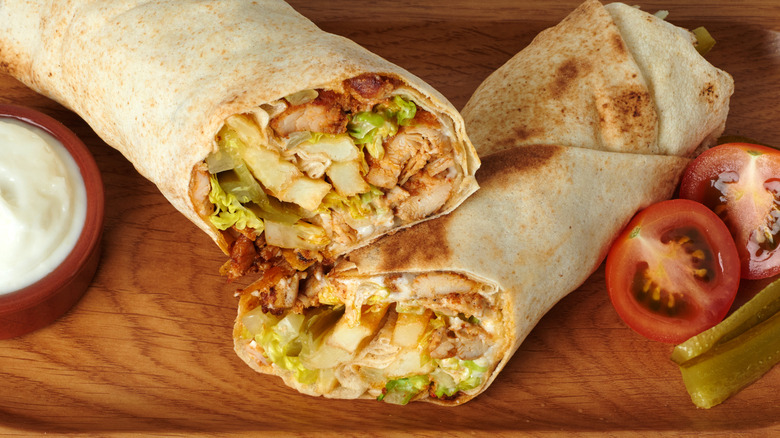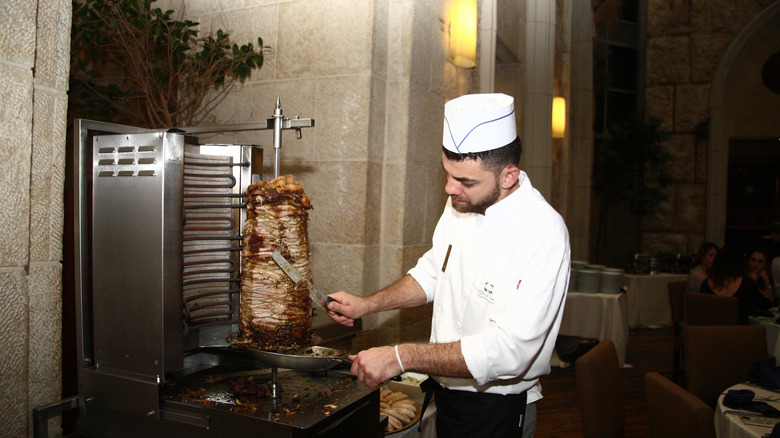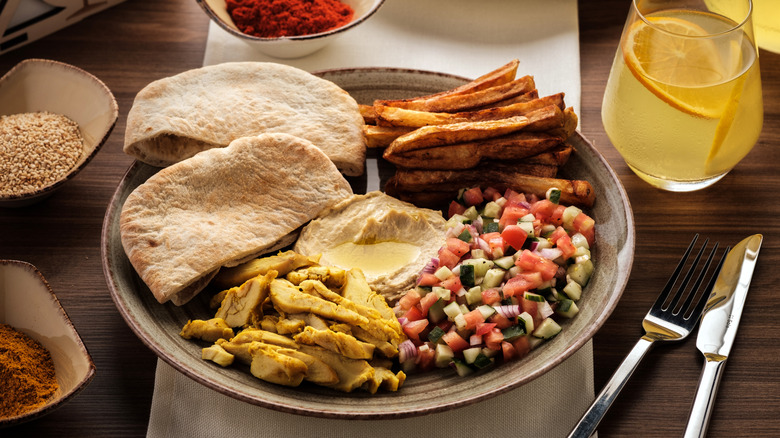These Common Spices Make Shawarma Easier Than You Think
Shawarma is an immensely popular Middle Eastern street food with a history as rich as the flavorful dish itself. Originating in Turkey during the 19th century, the word shawarma is an Arabic derivative of çevirme, the Turkish verb "to turn." The name refers to the meat's cooking method: stacked high on a spit and slowly spun while roasting. Through migration, shawarma has become a sought-out snack across the globe, even inspiring the invention of Mexico's beloved tacos al pastor in the 1960s.
Though the thought of tackling such a culturally cherished dish may seem intimidating, there are a few common spices that make prepping shawarma at home a breeze. To help build your shawarma confidence, Food Republic spoke to chef Jilbert El-Zmetr, founder of Laziza in Brooklyn.
"Shawarma is such a nostalgic food for so many people around the world," El-Zmetr said, who grew up enjoying the dish at his parents' restaurants in Australia. "That's real street food right there." Wrapped in pita and dressed with pickled vegetables and tangy sauce, the main star of any shawarma is typically either chicken, lamb, or beef –– each of which gets seasoned differently, according to El-Zmetr.
"Chicken leans more into the seven spice mix [allspice, coriander, cinnamon, black pepper, clove, cumin, and nutmeg] with some lemon slices and white vinegar, as well as plenty of garlic and salt," he explained. When it comes to lamb and beef, however, "salt, cumin, coriander, cardamom, paprika, and hints of cinnamon are your go-to spices."
The regional spice differences between shawarma, gyro, and döner
If the fundamentals of shawarma sound suspiciously similar to other spit-roasted meat sandwiches like gyros or döner kebabs, that's because all three of these dishes share the same origin story. It all started with the giant meat-stacked döner kebab, which was innovated during the Ottoman Empire by a butcher named İskender, in the Turkish city of Bursa. "Turkiye also has very varied style of Shawarma (Doner more technically) that is also influenced by [geography] and the countries and cultures that reside within close proximity to Turkiye's borders," said chef Jilbert El-Zmetr. From its Turkish origins, this style of rolled kebabs spread into neighboring Arab countries where it became known as shawarma.
According to El-Zmetr, spices used in shawarma across the Levantine region tend to mirror the Lebanese seven spice blend. However, in specific areas of the Middle East like Israel, Iraq, and the United Arab Emirates, "the flavors are a lot more varied given the influences of ethnic communities that have settled in those places over time."
The famous Greek gyro is also a result of the döner kebab's culinary migration. "There aren't too many differences between true gyros and shawarma," El-Zmetr explained. "While there will be variations in spice blends, the meats used are generally the same." The predominant difference between the two lies can be found in their seasonings and toppings. "Gyro is just another way of saying Shawarma — maybe with a little tzatziki for good measure," said El-Zmetr.
How to expertly marinate and cook shawarma at home
The key to a succulent shawarma starts with the right blend of spices, "together with some yogurt to help tenderize the meat before cooking," said chef Jilbert El-Zmetr. It may be tempting to mix heaps of seasoning into your yogurt-based marinade in order to infuse the meat with flavor, but El-Zmetr warns that less is more. "Over seasoning is so common –– Middle Eastern food in general is about hints of flavor and fragrance," he noted. "Be conservative with your spice mix and let the meat speak for itself." While tastes and spice tolerances vary, try starting with one or two teaspoons of each spice per cup of yogurt used. "I love adding sliced onions to the marinade as well," said El-Zmetr, who recommends marinating your meat at least overnight but ideally for two to three days.
When it's time to cook your shawarma, don't worry about doing it exactly like the pros. "Most homes aren't equipped with a vertical rotisserie, so the fry pan is your best friend," said El-Zmetr. Before marinating, try using a mandolin to get ultra-thin slices of meat that will cook quickly while retaining moisture. "Very thinly sliced pieces fried in some neutral oil at high heat will give you a nice balance of char on the outside and juiciness," he explained. El-Zmetr also suggested retaining your pan drippings to drizzle atop the cooked meat and "get the best out of your marinade."



